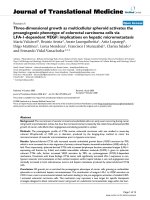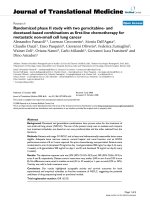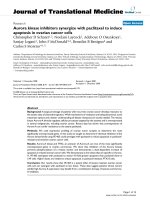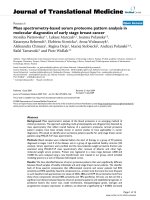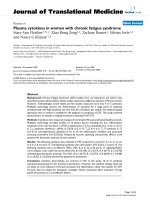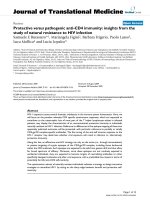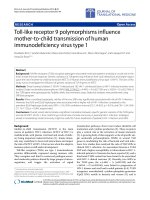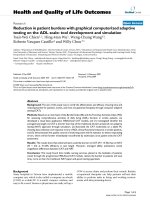báo cáo hóa học:" Do South Asian women with PCOS have poorer health-related quality of life than Caucasian women with PCOS? A comparative cross-sectional study" docx
Bạn đang xem bản rút gọn của tài liệu. Xem và tải ngay bản đầy đủ của tài liệu tại đây (254.67 KB, 8 trang )
RESEARC H Open Access
Do South Asian women with PCOS have poorer
health-related quality of life than Caucasian
women with PCOS? A comparative
cross-sectional study
Georgina L Jones
1*
, Manisha Palep-Singh
2
, William L Ledger
3
, Adam H Balen
4
, Crispin Jenkinson
5
,
Michael J Campbell
6
, Hany Lashen
7
Abstract
Background: Polycystic ovary sy ndrome (PCOS) is the most common chronic endocrine disorder affecting women
of reproductive age. This study aimed to compare the HRQoL of South Asian and white Caucasian women with
PCOS, given that it is particularly common among women of South Asian origin and they have been shown to
have more severe symptoms.
Methods: The Polycystic Ovary Syndrome Questionnaire (PCOSQ) and the Short Form-36 (SF-36) were
administered in a cross-sectional survey to 42 South Asian and 129 Caucasian women diagnosed with PCOS
recruited from the gynaecology outpatient clinics of two university teaching hospitals in Sheffield and Leeds.
Additional clinical data was abstracted from medical notes. Normative data, collected as part of the Oxford Health
and Lifestyles II survey, was obtained to compare SF-36 result s with ethnically matched women from the general
UK population. Using the SF-36, normative HRQoL scores for women of South Asian origin were lower than for
Caucasian women. Given this lower baseline we tested whether the same relationship holds true among those
with PCOS.
Results: Although HRQoL scores for women with PCOS were lower than normative data for both groups, South
Asian women with PCOS did not have poorer HRQoL than their Caucasian counterparts. For both the SF-36 and
PCOSQ, mean scores were broadly the same for both Asian and Caucasian women. For both groups, the worst
two HRQoL domains as measured on the PCOSQ were ‘infertility’ and ‘weight’ , with respective scores of 35.3 and
42.3 for Asian women with PCOS compared to 38.6 and 35.4 for Caucasian women with PCOS. The highest scoring
domain for South Asian women with PCOS was ‘menstrual problems’ (55.3), indicating best health, and was the
only statistically significant difference from Caucasian women (p = 0.01). On the SF-36, the lowest scoring domain
was ‘Energy & Vitality’ for Caucasian women with PCOS, but this was significa ntly higher for Asian women with
PCOS (p = 0.01). The best health status for both groups was ‘physical functioning’, although this was significantly
lower for South Asian women with PCOS (p = 0.005). Interestingly, only two domains differed significantly from the
normative data for the Asian women with PCOS, while seven domains were significantly different for the Caucasian
women with PCOS compared to their normative counterparts.
Conclusions: The HRQoL differences that exist betw een South Asian and Caucasian women in the general
population do not appear to be replicated amongst women with PCOS. PCOS reduces HRQoL to broadly similar
levels, regardless of ethnicity and differences in the normative baseline HRQoL of these groups.
* Correspondence:
1
Senior Lecturer, Health Services Research Section, ScHARR, Regent Court, 30
Regent Street, Sheffield, S1 4DA, UK
Full list of author information is available at the end of the article
Jones et al. Health and Quality of Life Outcomes 2010, 8:149
/>© 2010 Jones et al; licensee BioMed Central Ltd. This is an Open Access article distributed under the terms of the Creative Commons
Attribution License (htt p://creativecommons.org/licenses/by/2.0), which permits unrestricted use, distribution, and reproduction in
any medium, pro vided the original work is properly cited.
Background
Polycystic ovary syndrome (PCOS) is the most c om-
mon endocrinological problem affecting women [1]
with a prevalence estimated at 4-25% depending on
the diagnostic criteria used [2,3]. Patients with PCOS
demonstrate a combination of charac teristics which
may include anovulation, oligo or amenorrhoea, hir-
suitism, acne, evidence of increased serum androgen
levels and morpholo gical changes in the ovary evident
on ultrasonography. Diagnosticall y, current practice
uses criteria agreed in Rotterdam 2003 [4]. Approxi-
mately 50% of PCOS patients a re obese [5]; a much
higher prevalence than the general population. There
is also a metabolic element to the condition in the
form of insulin resistance that may result in long-term
morbidity.
South Asian refers to those persons who originate
from the Indian subcontinent (India, Pakistan, Sri
Lanka, Bangladesh and Ne pal) [6]. In a community-
based study in the United Kingdom (UK), it was found
that polycys tic ovaries (PCO) were particularly common
among women of South Asian origin (52%) [7], com-
pared to the prevalence of PCO observed in a predomi-
nately Caucasian population (22%) [8]. The South Asian
population, in general, also exhibit a hig her prevalence
of insulin resistance and type 2 diabetes [9], which may
increase long term morbidit y among those with PCOS.
Recent research indicated higher insulin concentrations
and lower insulin sensitivity in South Asian women with
PCOS compared to Caucasian women with PCOS [10].
This research also concluded that South Asians pres ent-
ing with anovular PCOS were significantly younger, had
more severe hirsuitism and a higher prevalence of
acanthosis nigricans than their Caucasian counterparts.
Health-related quality of life (HRQoL), is a concept
used to describe the physical, social and emotional
effects of a disease and its associated treatments [11].
Research has shown a reduction in the HRQoL of
women with PCOS compared with healthy controls
[12-15]. Comparisons with other medical conditions and
gynaecological populations have also yielded particularly
low scores on psychological well-being and quality of
life for women with PCOS [13-16].
Overall, there has been a great paucity of research
comparing the influence of ethnicity or cultural back-
ground on HRQoL in women with PCOS. Two studies
have tentatively explored this relationship. A study com-
paring Brazilian women with PCOS living in Brazil with
Austrian women living in Aust ria found that, with the
exception of body weight, the Brazilian wome n had
worse HRQoL [17]. However, this was inter-country
research and the impact of cultural, social and economic
differences between the two countries is unexplained.
An intra-country study of Muslim immigrants in
Austria identified worse HRQoL in PCOS Muslim
immigrant women compared with their Austrian coun-
terparts [18]. However, the number of Muslim women
was very small-just 14 individuals - and no attempt was
made to control for any pre-existing differences in
HRQoL of the groups investigated. Only one study to
date has measured the HRQoL of a sample of Indian
women with PCOS and found high prevalence of
psychological distress in over 50% of the women as
measured using the Goldberg’ s General Health Ques-
tionnaire-28 (GHQ-28) [19].
Twenty percent of the world’ spopulationareSouth
Asian [6]. Figures from the 2000 census revealed that
there were 1.6 million South Asians living i n the United
States (0.7%) [20]. In 2 001, 1 million South Asians were
living in Canada (3%) [21], and in 1999, a further 1 mil-
lion living in Australia (1.3%) [22]. In the UK, 5.7% of
the population of England and Wales identify them-
selves as Asian or Asian-British [23]. In 2001, 4.0% of
the population were South Asian, comprising the largest
minority ethnic group [24]. Because of this, it is essen-
tial to understand better the impact of PCOS in South
Asian women to ensure cl inical treatments are well-
aligned to need.
The aim of this study was therefore to compare the
HRQoL of South Asian and Caucasian women with
PCOS, given that it is particularly common among
women of South Asian origin a nd they have been
shown to have more severe symptoms. Our hypothesis
was that South Asian women from the In dian subcont i-
nent with PCOS would show overall lower HRQoL than
Caucasian women with the condition.
Methods
Ethical approval for this study was obtained from the
local research ethics committees of South Sheffield and
Leeds West.
The sample was recr uited from all women diagnosed
with PCOS attending the outpatient gynaecology clinics
in Sheffield and Leeds from 2003 to 2006. In Sheffield,
subjects were also recruited through an existing PCOS
database. Ethnicity was established from the patient’s
medical records and recorded against the classification
recommended by the Office for National Statistics [23].
Body mass index (BMI), and evidence of polycystic
ovaries (PCO) on ultrasound, testosterone concentration
and acne were also recorded from the patient’s medical
notes. For the purposes of this study, women with
PCOS were classified as having a BMI either lower than
or exceeding 27.5 kg/m
2
to explore differences in risk
profile. This is lower than the standard classification
of obesity as BMI > 30 in a Caucasian population.
Jones et al. Health and Quality of Life Outcomes 2010, 8:149
/>Page 2 of 8
However, this cut-off of 27.5 kg/m
2
is recommended to
reflect the elevated risks of type 2 diabetes and cardio-
vascular disease for Asian populations [25,26]. Women
were excluded from the study if they had another major
illness that substantially influenced their quality of life
or another cause of androgen excess, e.g. androgen-
secreting tumours.
Patients eligible for the study were sent a covering let-
ter, information sheet and consent form to return if
they wished to participate. It has been argued that it is
best to use more than one type of questionnaire when
measuring health status and ideally this should comprise
a g eneric and disease specific questionnaire. This is so
comparisons can be made at a generic level and specifi-
cally to that disease [27]. Consequently, two health-
related quality of life questionnaires were a dminister ed
to each woman who had consented to participate; the
disease-specific Polycystic Ovary Syndrome Question-
naire (PCOSQ) [28] and the generic Sho rt Form-36 (SF-
36) [29].
The PCOSQ is currently the only validated, disease-
specific questionnaire available to measure the HRQoL
of women with PCOS [30-32] and was administered to
understand in more detail women’ s experiences of
PCOS symptoms. The PCOSQ contains 26 items, mea-
suring five areas of HRQoL: ‘ emotions’ (8 items e.g.
moody as a result of having PCOS?), ‘body hair’ (5 items
e.g. growth of visible hair on chin?), ‘weight’ (5 items e.g.
had t rouble dealing with your weight?), ‘infertility pro-
blems’ (4 items e.g. concerned with infertility problems?)
and ‘menstrual problems’ (4 items e.g. irregular men-
strual periods?).
The SF-36 is a well validated and widely used generic
health status tool [29] and was used to capture HRQoL
data that could be compared to the general population.
The SF-3 6 contains 36 items that divide int o nine areas
of HRQoL: ‘ general health perceptions’ (5 items),
‘ change in health’ (1 item), ‘ physical functioning’
(10 items), ‘role limitation due to physical factors’ (4
items) , ‘ role limitation due to emotional factors’ (3
items), ‘ bodily pain’ (2 items), ‘ social functioning’ (2
items), ‘mental health’ (5 ite ms) and ‘energy and vitality’
(4 items). Normative data, collected as part of the
Oxford Health and Life styles II survey, was obtained
(personal communication with Professor Crispin Jenkin-
son) to compare our patient sample to SF-36 results for
ethnically matched women from the UK general popula-
tion [33]. The data was selected based upon female sex
and known ethnicity that was either Asian or Caucasian.
Analysis
The age and testosterone concentration of Asian and
Caucasian women were compared using independent t-
tests. Chi-squared and Fisher’ s exact test were used to
analyse data on PCO appearance on ultrasound and
BMI > 27.5 kg/m
2
.
PCOS women in each ethnic group were compared to
the normative SF-36 data using a two tailed t-test. The
percentage difference (difference between the study
sample and normative data sample means, divided by
the normative data sample means) in SF-36 score rela-
tive to the general populations was calculated to high-
light the magnitude of the differences for the PCOS
samples.
Each item of the PCOSQ has a 7-point scale (7 repre-
sents optimal function and 1 the poorest). As with the
SF-36, wit hin each domain the sum score of the compo-
nent PCOSQ questions were recoded on a scale of 0-6
and then transformed to create a total range of 0 to
100. Responses to the SF-36 domains were calculated
into a range of 0-100 representing worst to best health
status.
All statistical analyses were performed using SPSS ver-
sion 14. The p-values are unadjusted for multiple
testing.
Results
A total of 171 women with confirmed PCOS completed
the PCOSQ and SF-36 from 258 women contacted by
post and an additional number recruited directly from
outpatient gynaecology clinics. Of these, 42 (24.6%)
were South Asian and 129 (75.4%) were Caucasian. The
South Asian population consisted predominantly of
women of Pakistani or Indian origin, either first or sec-
ond generation, with 1% of Bangladeshi origin. The
average ages o f the South Asian and Caucasian women
with PCOS were very similar with means of 30.0
yrs (range 20-42) and 30.3 yrs (17-48) respectively
(P = 0.60).
The testosterone concentration, evidence of PCO on
ultrasound and the number with a BMI > 28 kg/m
2
are
given in Table 1. In our sample, BMI did not signifi-
cantly differ between the South Asian and Caucasian
women with PCOS. However, both our samples had
high proportions of women exceeding the BMI cut-off
of 27.5 kg/m
2
with 72% and 73% of the samples respec-
tively exceeding this level. The only significant differ-
ence between the two ethnic groups was a greater
likelihood of polycystic ovarian appearance confirmed
on ultrasound in Caucasian women (p = 0.04).
The SF-36
On the SF-36, t he lowest mean tot al score and thus
worst area of HRQoL for the South Asian group was
observed for ‘general health’ (53.9) (Table 2). With in the
Caucasian group the mean total score was lowest for
‘energy and vitality’ (45.4). The highest and the refore
best health status for both groups was ‘ physical
Jones et al. Health and Quality of Life Outcomes 2010, 8:149
/>Page 3 of 8
functioning’ , although this was significantly lower for
SouthAsianwomenwithPCOS(73.0)thanforCauca-
sian PCOS women (87.3) (p = 0.005). ‘Energy an d vital-
ity’ was the only other domain to show a significant
difference between the two groups (p = 0.01). Other
domains were more similar and without a consistent
direction of difference.
The PCOSQ
With the PCOS-specific instrument, the South Asian
women’s lowest mean PCOSQ scores and thus worst
area of HRQoL were in the domains of ‘infertility’ (35.3)
and ‘weight’ (42.3) (Table 3) . These were also the lowest
scoring domains for Caucasian women (38.6 and 35.4
respectively). The highest scoring domain for South
Asian PCOS was ‘menstrual problems’ (55.3), indicating
best health, and was the only statistically significant dif-
ference fro m Caucasian women (p = 0.01). In contrast,
‘ body hair’ (54.9) was the highest scoring domain for
Caucasian women with PCOS.
Comparison with the general population
Data from the Oxford Health and Lifestyles survey were
used to indicate normal non-PCOS SF-36 scores for the
population within each ethnic group. This survey
includes 57 Asian women and 4897 Caucasian women.
This is the only normative data readily available, and
does have weakness in that it includes older age women.
Whereas the mean age of each PCOS group was 30
years, the survey d ata means were 35.8 yrs for Asian
women (p < 0.01) and 39.6 yrs (p < 0.01) for Caucasian
women. The limited sample si ze for the Asian
population responses means that matching methodolo-
gies, on age or other characteristics, were not possible
Asian women in the general population reported sig-
nificantly lower and therefore worse HRQoL on all
SF-36 domains compared with their Caucasian counter-
parts ( Table 4). On every domain, HRQoL scores were
lower for South Asian and Caucasian women with
PCOS compared with equivalent normative data for
their ethnicity (i.e. negative percentage difference in
Table 4). However, South Asian women with PCOS
showed only small decreases in HRQoL from the nor-
mative data in several domains; e.g. ‘energy and vitality’
and ‘physical functioning’ were 0.02% and 7.2% lower
respectively. The only two statistically significant
HRQoL differences for South Asian PCOS women were
for ‘social functioning’ (p = 0.01) and ‘ general health’
perceptions’ (p = 0.02), which were 17.8% and 16.4%
lower than the normative data. None of the domain
means for the South Asian women with PCOS were
more than 20% lower than the Asian general population.
In contrast, seven statistically significant HRQoL dif-
ferences for Caucasian women with PCOS were
observed and they showed lower HRQoL of 20% or
more from the normative data in five domains , with the
biggest differences being ‘role limitations-emotional’ and
‘social functioning’ showing 33.5% (p < 0.01) and 24.8%
(p < 0.01) lower HRQoL.
Discussion
The aim o f this pap er was to compare the HRQoL of
South Asian and Caucasian women diagnosed with
PCOS. Exis ting research has ident ified a younger age of
Table 2 Comparison of the Asian PCOS and Caucasian PCOS mean SF-36 domain scores.1
SF-36 Asian PCOS Mean Caucasian PCOS Mean Difference 95% CI Two tailed significance
Bodily Pain 61.4 (n = 42) 67.3 (n = 126) 5.9 -3.5 to 15.3 p = 0.22
Energy and Vitality 54.9 (n = 40) 45.4 (n = 127) 9.5 -16.9 to -2.0 p = 0.01
General Health 53.9 (n = 40) 57.8 (n = 125) 4.0 -4.0 to 11.9 p = 0.33
Mental Health 60.0 (n = 41) 57.6 (n = 127) 2.4 -9.6 to 4.8 p = 0.52
Physical Functioning 73.0 (n = 39) 87.3 (n = 124) 14.4 4.5 to 24.1 p = 0.005
Role Limit/Emotion 64.3 (n = 42) 53.9 (n = 125) 10.4 -24.6 to 3.8 p = 0.15
Role Limit/Physical 67.3 (n = 42) 77.6 (n = 126) 10.3 -1.9 to 22.5 p = 0.10
Social Functioning 64.9 (n = 41) 65.3 (n = 127) 0.3 -9.7 to 10.3 p = 0.95
1
. 0 (Indicating Worst Health Status) to 100 (Best Health Status)
Table 1 Clinical Features of the Patient Sample
Total Patients Asian Caucasian Two-tailed significance
Sample size 171 42 129
BMI >27.5 kg/m
2
106 (72.6%) 28 (71.8%) 78 (72.9%) p = 0.90
PCO on Ultrasound 143 (93.5%) 29 (85.3%) 114 (95.8%) p = 0.04*
Testosterone ng/dl: Mean (SD) 2.37 (0.90) 2.59 (0.70) 2.30 (0.95) p = 0.12
* (Fisher’s Exact Test)
Jones et al. Health and Quality of Life Outcomes 2010, 8:149
/>Page 4 of 8
presentation with oligomen orrhoea, increased hirsutism,
acne, acanthosis nigricans and infer tility in South Asian
women from the Indian subcontinent with PCOS as
compared with Caucasian women with PCOS [7,10,34].
For this reason, we anticipated that the HRQoL scores
of South Asian women with PCOS would be worse than
for Caucasian women with the condition. This expecta-
tion was reinforced by knowledge from the Oxford
Health and Lifestyles Survey II that showed lower
HRQoL among Asian women generally.
Overall, rather than finding consistent differences, we
found the HRQoL of Asian and Caucasian women with
PCOS to be broadly similar when measured with the
condition-specific questionnaire (PCOSQ). T he only
domain of the P COSQ to show a significant difference
between the two groups was ‘menstrual problems’ ,
which was found to be of least concern for Asian
women with the condition. Wijeyratne et al [10] found
that Asian women began experiencing oligomenorrhoea
at a younger age. This significant difference may be the
result of a longer period of adjustment to the menstrual
problems for the Asians and/or earlier presentation to
speci alist services. However, a further longitudinal study
would be needed to explore this hypothesis.
Consistent with other cross-sectional studies of
women with P COS [12,13,30,31,35,36], we found that
weight and infertility were the worst domains on the
PCOSQ for both ethnic groups. This is perhaps not
surprising given that the metabolic profile of the con-
dition means that is very difficult for a PCOS woman
to lose weight. Indeed, with the exception of surgery,
interventions to lose weight are often unsuc cessful and
associated with high rates of weight regain [37]. Thus
it is perhaps not surprising that many PCOS women
typically report frustration in losing weight, low self-
esteem and consequently a poor body image [28]. I n
relation to weight, a poor body image in PCOS women
may be compounded by cultural influences as it has
been shown that android fat pattern, commonly asso-
ciated with PCOS, is considered unattractive in many
cultures [38,39]. However, other explanations particu-
larly found in Western cultures regarding women, for
example societal expectations of thinness, may also be
responsible.
Table 3 Comparison of the Asian PCOS and Caucasian PCOS mean PCOSQ domain scores.1
PCOSQ Asian PCOS Mean Caucasian PCOS Mean Difference 95% CI Two tailed significance
Body Hair 50.8 (n = 41) 54.9 (n = 126) 4.1 -7.8 to 16.0 p = 0.50
Emotions 51.0 (n = 36) 51.9 (n = 120) 0.8 -8.7 to 10.4 p = 0.86
Infertility 35.3 (n = 41) 38.6 (n = 121) 3.3 -7.7 to 14.3 p = 0.55
Menstrual Problems 55.3 (n = 41) 43.5 (n = 121) -11.8 -20.6 to -3.0 p = 0.01
Weight 42.3 (n = 40) 35.4 (n = 125) -6.9 -18.6 to 4.9 p = 0.25
1
. 0 (Indicating Worst Health Status) to 100 (Best Health Status)
Table 4 Percentage difference in HRQoL for PCOS women relative to the SF-36 scores from the normative data
SF-36
Domain
* Normative
Asian mean
South Asian PCOS (% difference
from normative Asian)
P value * Normative
Caucasian mean
Caucasian PCOS (% difference
from normative Caucasian)
P value
Bodily Pain 69.8 (n = 57) -12.0 p = 0.12 79.6 (n = 4834) -15.5 p < 0.01
Energy and
Vitality
55.0 (n = 51) -0.02 p = 0.98 58.9 (n = 4769) -23.0 p < 0.01
General
Health
64.5 (n = 57) -16.4 p = 0.02 73.8 (n = 4751) -21.7 p < 0.01
Mental
Health
67.7 (n = 56) -11.4 p = 0.08 72.3 (n = 4737) -20.0 p < 0.01
Physical
Functioning
78.7(n = 53) -7.2 p = 0.31 87.8 (n = 4650) -0.06 p = 0.06
Role Limit/
Emotion
72.7 (n = 55) -11.6 p = 0.28 81.0 (n = 4801) -33.5 p < 0.01
Role Limit/
Physical
79.8 (n = 52) -15.7 p = 0.09 84.2 (n = 4801) -7.8 p = 0.01
Social
Functioning
79.0 (n = 54) -17.8 p = 0.01 86.8 (n = 4836) -24.8 p < 0.01
NB. SF-36 range: 0 (Worst Health Status) to 100 (Best Health Status)
* Data obtained from the Oxford Health and Lifestyles II survey from a personal communication with Professor Crispin Jenkinson.
Jones et al. Health and Quality of Life Outcomes 2010, 8:149
/>Page 5 of 8
Higher mean scores (indicating a better HRQoL) were
found on the SF-36 compared with the PCOSQ, prob-
ably because of the generic nature of the questionnaire:
one limitation of using generic measures is that they
may not be sensitive enough to assess changes in speci-
fic illnesses as they are designed to measure HRQoL
across a wide varie ty of diseas es [27]. Questionnaires
designed specifically for patients with a given disease
should be more responsive or sensitive to changes in
health status because they contain items from relevant
patient groups. Asian women with PCOS scored worse
than Caucasian women with PCOS on the ‘ physical
functioning’ and ‘ role limitation: physical’ domains.
However, these had relatively high HRQoL scores for
both groups, which is consistent with other research
showing it is the physical do mains of the SF-36 where
PCOS has the least impact [13]. In contrast, ‘Energy and
Vitality’ was the lowest scoring SF-36 domain for Cauca-
sian women with PCOS women and also significantly
lower than for Asian women with the condition.
The results from both PCOSQ and SF-36 lead us to
conclude that HRQoL is not significantly worse for
Asian women with PCOS than it is for Caucasian
women with PCOS. In fact, the only significant differ-
ences between the two groups in domains where PCOS
symptoms have a major impact, actually showed worse
HRQoL for Caucasian women (’menstrual problems’ on
the PCOSQ and ‘energy and vitality’ on the SF-36). This
result is surprising, since the S F-36 normative data
showed Asian women had significantly poorer HRQoL
scores than Caucasian women. Tentatively, it suggests
that serious h ealth disorders mig ht reduce HRQoL to
similar levels, regardless of starting HRQoL and over-
rides less severe HRQoL factors.
There are a number of limitations to this research.
Our study sample data were obtained from women with
PCOS attending outpatient gynaecology clinics and
therefore are limited to those PCOS women who attend
a clinic, rather than a wider population including
women with PCOS not having treatment. The norma-
tive data with which comparison is made were collected
in 1993 and did not contain any finer level ethnicity
data than ‘Asian’. This broad ethnic grouping will mean
thatitmaynotbeaprecisematchforthoseSouth
Asian women with PCOS from the Indian sub-continent
that we recruited in clinic, especially as they were also
significantly older.
While this is the largest study to date that has com-
pared the HRQoL of PCOS women from different ethni-
cities, it needs to be recognised tha t a sample of 42
Asian PCOS women and the small normative data set
for the Asian population is not optimal. Recruitment of
minority ethnic women proved problematic in our study
as reported in other forms of health research [40], and
highlights how any advances in engaging such groups to
participate would be beneficial.
A high level of obesity is found in both Caucasian and
South Asian populations. The traditional cut-off points
for BMI are overweight (25 kg/m
2
<30kg/m
2
)and
obese as (> 30 kg/m
2
). However, these related to risk
thresholds for mortality and morbidity in mainly Eur-
opean populations [41]. Increasingly, evidence sug gests
that even with a low BMI (< 25 kg/m
2
), South Asian’ s
suffer an increased risk of hypertension, diabetes and
dislipidemia and therefore the BMI thresholds have
been lowered to 23 kg/m
2
(overweight) and 25 kg/m
2
(obese) to reflect this risk for this population [25].
Recent publications have also stressed the need to mea-
sure beyond BMI and also measure waist circumference;
it i s more directly proportional to total body fat and th e
amount of metabolically active visceral fat and therefo re
is a more accurate measure of metabolic risk [42].
Recently, the waist circumference threshold has also
been reduced to reflect a hig h risk profile to >/= 80 cm
for Asian Indian women [26]. Thus in future studie s of
ethnicity, PCOS and HRQoL, the relationship between
this paramet er and HRQoL outcomes may give a more
accurate picture of the role of weight upon a woman’s
health status, especially given the confusing and conten-
tious state of using different BMI cut-offs for different
ethnicities.
Conclusion
PCOS has a major n egative impact upon HRQoL,
regardless of whether women are from an Asian or Cau-
casian ethnic background, with weight and infertility
worst affected by the condition. But although there is
evidence of poorer HRQoL for Asian women in the gen-
eral population than for Caucasian women, Asian
women do not seem to have identifiably poorer HRQoL
with PCOS than Caucasian women with PCOS. This
suggests that effective management of H RQoL of Asian
women with PCOS may not differ from more main-
stream practices.
Acknowledgements
We would like to thank Dr Anthony Moody for his assistance with proof
reading the manuscript and Katie Bowen and Jennie Hall for their assistance
with recruitment.
Author details
1
Senior Lecturer, Health Services Research Section, ScHARR, Regent Court, 30
Regent Street, Sheffield, S1 4DA, UK.
2
Consultant Gynaecologist &
Subspecialist in Reproductive Medicine & Surgery, Saint Mary’s University
Teaching Hospital & CMMC NHS Trust, Manchester, M13 0JH, UK.
3
Professor,
Academic Unit of Reproductive & Developmental Medicine, Jessop Wing
Hospital, Tree Root Walk, Sheffield, S10 2TJ, UK.
4
Professor, United Leeds
Teaching Hospitals, Clarendon Wing, Leeds General Infirmary, LS2 9NS, UK.
5
Professor, Department of Public Health, University of Oxford, Old Road
Campus, Headington, Oxford, OX3 7LF, UK.
6
Professor, Medical Statistics Unit,
ScHARR, Regent Court, 30 Regent Street, Sheffield, S1 4DA, UK.
7
Senior
Jones et al. Health and Quality of Life Outcomes 2010, 8:149
/>Page 6 of 8
Lecturer, Academic Unit of Reproductive & Developmental Medicine, Jessop
Wing Hospital, Tree Root Walk, Sheffield, S10 2TJ, UK.
Authors’ contributions
GJ conceived of the study, participated in its design, performed the
statistical analysis and drafted the manuscript for publication. MS conceived
of the study, participated in its design and assisted with recruitment. WL
conceived of the study and participated in its design. AB conceived of the
study and participated in its design. CJ provided and assisted with the
analysis of the SF-36 normative data. MJC assisted with the statistical
analysis. HL participated in the study design and assisted with recruitme nt.
All authors read and approved the final manuscript.
Competing interests
The authors declare that they have no competing interests.
Received: 1 March 2010 Accepted: 20 December 2010
Published: 20 December 2010
References
1. Hart R, Hickey M, Franks S: Definitions, prevalence and symptoms of
Polycystic ovaries and Polycystic ovary syndrome. Best Pract Res Clin
Obstet Gynaecol 2004, 18:671-683.
2. Homberg R: What is polycystic ovarian syndrome? - A proposal for a
consensus on the definition and diagnosis of polycystic ovarian
syndrome. Hum Reprod 2002, 17:2495-2499.
3. Balen A, Michelmore K: What is polycystic ovary syndrome? Are national
views important? Hum Reprod 2002, 17:2219-2227.
4. Rotterdam ESHRE/ASRM-Sponsored PCOS consensus workshop group:
Revised 2003 consensus on diagnostic criteria and long-term health
risks related to polycysticovary syndrome (PCOS). Hum Reprod 2004,
19:41-7.
5. Gambineri A, Pelusi C, Vicennati V, Pagotto U, Pasquali R: Obesity and the
polycystic ovary syndrome. International Journal of Obesity and Related
Metabolic Disorders 2002, 26:883-896.
6. Tziomalos K, Weerasinghe CN, Mikhailidis DP, Seifalian AM: Vascular risk
factors in South Asians. International Journal of Cardiology 2008,
128:5-16.
7. Rodin DA, Bano G, Bland JM, Taylor K, Nussey SS: Polycystic ovaries and
associated metabolic abnormalities in Indian subcontinent Asian
women. Clin Endocrinol 1998, 49:91-99.
8. Clayton RN, Hogkinson J, Worswick L, Rodin DA, Dyer S, Meade TW: How
common are polycystic ovaries in normal women and what is their
significance for the fertility of the population? Clin Endocrinol 1992,
37:127-134.
9. Wild S, Roglic G, Green A, Sicree R, King H: Global prevalence of diabetes:
estimates for the year 2000 and projections for 2030. Diabetes Care 2004,
27:1047-53.
10. Wijeyaratne CN, Balen AH, Barth JH, Belchetz PE: Clinical manifestations
and insulin resistance (IR) in polycystic ovary syndrome (PCOS) among
South Asians and Caucasians: is there a difference? Clin Endocrinol 2002,
57:343-350.
11. Colwell H, Mathias SD, Pasta DJ, Henning JM, Steege JF: A health-related
quality of life instrument for symptomatic patients with endometriosis: a
validation study. Am J Obstet Gynecol 1998, 179:47-55.
12. Ching HL, Burke V, Stuckey BG: Quality of life and psychological morbidity
in women with polycystic ovary syndrome: body mass index, age and
the provision of patient information are significant modifiers. Clin
Endocrinol (Oxf) 2007, 66:373-379.
13. Coffey S, Bano G, Mason HD: Health-related quality of life in women with
PCOS: A comparison with the general population using the PCOSQ and
the SF-36. Gynecol Endocrinol 2006, 22:80-6.
14. Hahn S, Janssen OE, Tan S, Pleger K, Mann K, Schedlowski M, Kimmig R,
Benson S, Balamitsa E, Elsenbruch S: Clinical and psychological correlates
of quality-of-life in polycystic ovary syndrome. Eur J Endocrinol 2005,
153:853-860.
15. Elsenbruch S, Hahn S, Kowalsky D, Offner AH, Schedlowski M, Mann K,
Janssen OE: Quality of life, psychosocial well-being, and sexual
satisfaction in women with polycystic ovary syndrome. J Clin Endocrinol
Metab 2003, 88:5801-7.
16. Trent ME, Rich M, Austin SB, Gordon CM: Quality of life in adolescent girls
with polycystic ovary syndrome. Arch Pediatr Adolesc Med 2002,
156:556-60.
17. Hashimoto DM, Schmid J, Martins FM, Fonseca AM, Andrade LH,
Kirchengast S, Eggers S: The impact of the weight status on subjective
symptomatology of the Polycystic Ovary Syndrome: a cross-cultural
comparison between Brazilian and Austrian women. Anthropol Anz 2003,
61:297-310.
18. Schmid J, Kirchengast S, Vytiska-Binstorfer E, Huber J: Infertility
caused by PCOS–health-related quality of life among Austrian and
Muslim immigrant women in Austria. Hum Reprod 2004,
19:2251-2257.
19. Sundararaman PG, Shweta , Sridhar GR: Psychosocial aspects of women
with polycystic ovary syndrome from south India. J Assoc Physicians India
2008, 56:945-948.
20. US Census Bureau (2004) We the People: Asians in the United States.
[ />21. Statistics Canada (2005) South Asians in Canada: Unity through diversity.
[ />22. Price C: Australian Population: Ethnic Origin. People and Place. 1999,
7(4):12-16[ />pdf].
23. Office for National Statistics. 2004 [ />asp?id = 455].
24. Office for National Statistics (2003) Ethnic group statistics. A guide for
the collection and classification of ethnicity data. [ />about-statistics/measuring-equality/equality/ethnic-group-statistics/index.
html].
25. Misra A, Chowbey P, Makkar BM, Vikram NK, Wasir JS, Chadha D, Joshi SR,
Sadikot S, Gupta R, Gulati S, Munjal YP, Concensus Group: Consensus
statement for diagnosis of obesity, abdominal obesity and the
metabolic syndrome for Asian Indians and recommendations for
physical activity, medical and surgical management. J Assoc Physicians
India 2009, , 57: 163-70.
26. Misra A, Khurana L: Obesity-related non-communicable diseases: South
Asians vs White Caucasians. Int J Obes (Lond) 2010.
27. Patrick DL, Bergner M: Measurement of health status in the 1990s. Annual
Review of Public Health 1990, 11:165-83.
28. Cronin L, Guyatt G, Griffith L, Wong E, Azziz R, Futterweit W, Cook D,
Dunaif A: Development of a health-related quality-of-life questionnaire
(PCOSQ) for women with polycystic ovary syndrome (PCOS). J Clin
Endocrinol Metab 1998, 83:1976-1987.
29. Ware JE Jr, Sherbourne CD: The MOS 36-item short-form health survey
(SF-36). I. Conceptual framework and item selection. Med Care 1992,
30:473-483.
30. Jones GL, Benes K, Clark TL, Denham R, Holder MG, Haynes TJ, Mulgrew NC,
Shepherd KE, Wilkinson VH, Singh M, Balen A, Lashen H, Ledger WL: The
polycystic ovary syndrome health-related quality of life questionnaire
(PCOSQ): a validation. Hum Reprod 2004, 19:371-7.
31. Guyatt G, Weaver B, Cronin L, Dooley JA, Azziz R: Health-related quality of
life in women with polycystic ovary syndrome, a self-administered
questionnaire, was validated. J Clin Epidemiol 2004, 57:1279-87.
32. Jedel E, Kowalski J, Stener-Victorin E: Assessment of health-related quality
of life: Swedish version of polycystic ovary syndrome questionnaire. Acta
Obstet Gynecol Scand 2008, 87:1329-35.
33. Jenkinson C, Coulter A, Wright L: Short Form 36 (SF-36) health survey
questionnaire: normative data for adults of working age. BMJ 1993,
306:1437-40.
34. Zargar AH, Wani AI, Masoodi SR, Laway BA, Bashir MI, Salahuddin M:
Epidemiologic and etiologic aspects of hirsutism in Kashmiri women in
the Indian subcontinent. Fertil Steril 2002, 77:674-8.
35. McCook JG, Reame NE, Thatcher SS: Health-related quality of life issues in
women with polycystic ovary syndrome. J Obstet Gynecol Neonatal Nurs
2005, 34:12-20.
36. Barnard L, Ferriday D, Guenther N, Strauss B, Balen AH, Dye L: Quality of
life and psychological well being in polycystic ovary syndrome. Hum
Reprod 2007, 22:2279-86.
37. Hoeger KM: Role of lifestyle modification in the management of
polycystic ovary syndrome. 2006, 20:293-310.
38. Brown PJ: Culture and evolution of obesity. Hum Nat 1991, 2:31-57.
Jones et al. Health and Quality of Life Outcomes 2010, 8:149
/>Page 7 of 8
39. Deurenberg P, Deurenberg-Yap M, Guricci S: Asians are different from
Caucasians and from each other in their body mass index/body fat per
cent relationship. Obesity reviews 2002, 3:141-146.
40. Dawood M: Sampling rare populations. Nurse Res 2008, 15:35-41.
41. World Health Organisation: Obesity: Preventing and Managing the Global
Epidemic. Report on a WHO Consultation on Obesity 1997 Geneva,
Switzerland. Geneva: WHO/NUT/NCD; 1998.
42. Haslam D, Sattar N, Lean M: Obesity-time to wake up. BMJ 2006,
333:640-642.
doi:10.1186/1477-7525-8-149
Cite this article as: Jones et al.: Do South Asian women with PCOS have
poorer health-related quality of life than Caucasian women with PCOS?
A comparative cross-sectional study. Health and Quality of Life Outcomes
2010 8:149.
Submit your next manuscript to BioMed Central
and take full advantage of:
• Convenient online submission
• Thorough peer review
• No space constraints or color figure charges
• Immediate publication on acceptance
• Inclusion in PubMed, CAS, Scopus and Google Scholar
• Research which is freely available for redistribution
Submit your manuscript at
www.biomedcentral.com/submit
Jones et al. Health and Quality of Life Outcomes 2010, 8:149
/>Page 8 of 8
